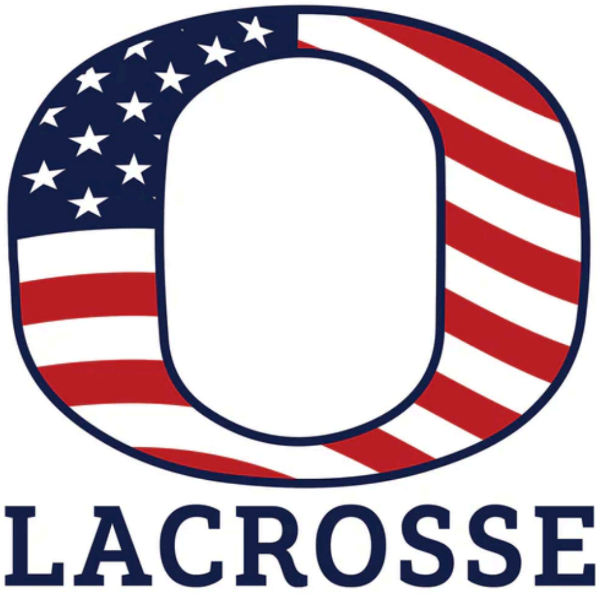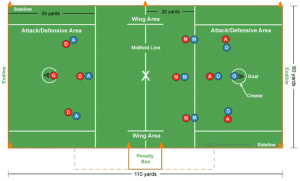Number of Players & Positions
In the game of lacrosse there are ten players on each team. Each team has a goalie, three attackman, three defensemen and three midfielders.
Attackman
The attackman play on the offensive end of the field, near the opponent's goal, and try to dodge the defensemen playing against them and shoot on the goal, pass to or FEED one of their teammates who will take a shot, or cut to the goal to get a feed from one of their teammates. If the goalie stops a shot or the defense otherwise get possession on the ball, the attackman then must try to prevent the defense from CLEARING, by RIDING the defensive players that are trying to advance the ball up field.
During a FACE-OFF, the three attackman start behind the RESTRAINING LINE, which is a line that runs across the field and is 20 yards from the midfield line. Once one of the teams gains possession after the face-off and the referee yells "possession," the attackman are free to run up to the midfield line. Attackmen cannot cross over the midfield line. If they do they will be called OFFSIDES by the referee. The only exception is where a midfielder or defensemen on their team stays back on the offensive end of the field so that there are three players on the offensive half of the field. In that case the attackman could cross over the midfield line.
Defensemen
Defensemen are charged with the job of protecting the goal by preventing the other team from scoring. They will often have to play one-on-one defense against a dodging attackman and, when the guy they are playing does not have the ball, they have to "sluff-in" towards the middle of the defense so that they are in a position to help if one of their teammates needs help. When a defensemen leaves his man to help one of his teammates, this is called SLIDING, and you'll often hear coaches yell "slide" "slide" slide."
In addition to trying to prevent the other team from scoring, defensemen also have to help CLEAR the ball, which means clear the ball from the defensive end of the field to the offensive end. On a FACE-OFF the three defensemen must stay behind the RESTRAINING LINE, but they can cross over the RESTRAINING LINE and go to the midfield line after the FACE-OFF once one team gains possession of the ball and the referee yells "possession."
The referee will call "OFFSIDES" if there are not four players on the defensive side of the field when the balls moves to the offensive end. Generally, that means that the goalie and the three defensemen cannot cross the midfield line. However, often, when the defense is CLEARING the ball, a defensemen will carry the ball over the midfield line himself, and he will not be called OFFSIDES so long as one of his teammates has stayed back on the defensive half of the field, so that there are still four players on the defensive half of the field. When you hear a coach or the players yelling "stay back," they are telling their teammates to stay on the defensive half of the field so a clearing defensemen or goalie can go over the midfield line.
Midfielders
These guys are the real workhorses because they have to play both offense and defense and be able to run the entire length of the field. There are three midfielders on the field at a time and, on the FACE-OFF, one midfielder takes the FACE-OFF, while the other two stand on the two WING LINES that are located to the sides of the FACE-OFF area and 10 yards from each sidelines.
If the other team gets possession of the ball on the FACE-OFF, the three midfielders or "middies" must drop back to the defensive side of the field and help their team by trying to stop the other team from scoring. When on defense, a midfielder will have to stop is man from dodging when his man has the ball, and when his man does not have the ball, sluff-in a little to the middle of the defense to help play team defense. When playing team defense, the midfielder has two responsibilities. He has to watch the guy he's playing against and be prepared to cover him if he cuts to the goal for a FEED, and he also has to be ready to SLIDE to help play defense if one of the other offensive player beats his man and is charging towards the goal. You'll often hear coaches yelling "have your head on a swivel" or "eye on the man, eye on the ball." With those commands the coach is reminding the player of his dual responsibilities when on defense.
When their team has the ball on the offensive half of the field, the midfielders will try to dodge and/or beat their man the man playing against them for a shot on goal, cut hard to the goal to try and get a FEED from one of their teammates, or FEED on their teammates who are cutting towards the goal.
Goalies
A goalie's job seems pretty straightforward. His main task is to try and stop shots. But in the game of lacrosse, goalies play a much larger role. One of their most important jobs is to communicate to the midfielders and defensemen when the ball is in the defensive half of the field. Because the midfielders and defensemen often have their backs to wherever the ball is (for example, when they're watching the guy they're playing against), they often do not know where it is on the field, and the goalie constantly needs to yell to tell them where the ball is on the field. For example, you'll often hear goalies yelling "top left" or "top right." In those examples, the goalie is telling the defense that the ball is being held by the right or left offensive midfielder. Goalies must also let the the defense know when they need to help out by sliding, so you'll hear them yell "slide" or a special call sign they have for sliding, like "crash." You'll also hear goalies giving instructions to the defensemen or midfielder playing against a dodging opponent, so that they know when the offensive guy is getting too close to the goal.
In addition to stopping shots and communicating with the defensemen and midfielders, the goalie must help CLEAR the ball. In that role, goalies must have the ability to evade a RIDING attackmen, and make an outlet or clearing pass to one of his defensemen or midfielders. Like the defensemen, the goalie must stay on the defensive half of the field, but can cross-over the midfield line if someone such as one of the midfielders on his team, stays back on the defensive side for him.
There are few rules unique to goalies. For instance, if the goalie makes a save or otherwise gets possession of the ball in the CREASE, he cannot be checked by the opposing team and, if he is checked when in the process of making a clearing pass from within the CREASE, the referee will call INTERFERENCE on the player who checked him and the goalies team will be awarded a FREE CLEAR, which means they get to start with the ball on their side of the midfield line. However, the goalie can't side with the ball forever in the CREASE. After he gains possession of the ball, a goalie has 4 seconds to get the ball outside of the CREASE, either by passing or running it out. If the goalie fails to get the ball out of the CREASE within 4 seconds, the ball will awarded to the other team. Other rules unique to goalies apply when a goalie reaches outside of the CREASE. Generally, in grades 6th and below, when a goalie traps a ball with his CROSSE (i.e., stick) outside of the CREASE, the referee will yell "goalie ball," which means no one can check his stick. Starting in the 7th grade, an offensive player can check the stick of a goalie who traps the ball outside of the CREASE, but cannot check the stick of the goalie has possession of the ball outside of the CREASE.
Positions on the Field
The figure to the right shows a lacrosse field with players from both teams. In the figure the red team has the ball on offense.

